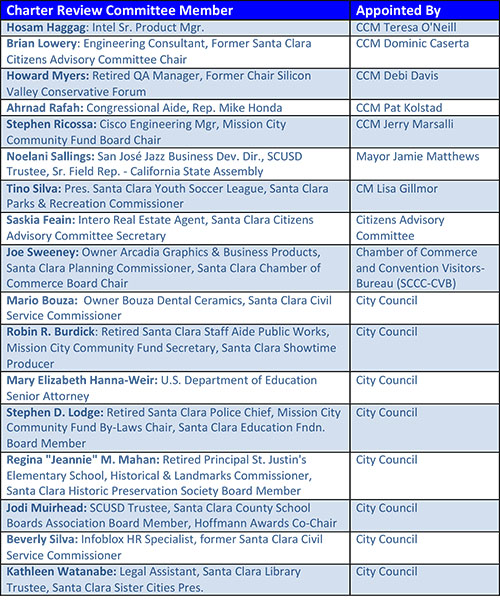
As the City Council considers changes in the way its members are elected, it’s a good time to reflect that this isn’t the first time Santa Clara has considered the governance issues that have come under recent scrutiny. In 1971 there was considerable discussion about whether Santa Clara’s then 20 year-old Charter needed changing.
But 40 years ago, election methods took a back seat to other issues considered more pressing; foremost was whether the city should appoint, rather than elect, its Police Chief and City Clerk.
In November 1971, the City Council appointed a 15-member charter review committee to consider changes to the city’s 1951 charter, reported the San Jose Mercury on Dec. 20, 1971 in a story titled, “S.C. Charter Changes Galore Proposed.” These included:
- Making the Police Chief and City Clerk appointive rather than elective, and establishing professional qualifications for both
- Requiring city employees to live within city boundaries
- Putting the Library Board on an advising, rather than directing, basis – the same as other city committees
- Electing City Council Members by district and eliminating term limits
- A referendum on Santa Clara’s city manager form of government
- Increasing the Mayor’s salary to $30,000 per year (roughly $139,000 in 2016 dollars) and requiring that mayors have no outside business interests
The 1971 committee was appointed differently than this year’s committee. Instead of one committee member appointed by each Council Member and eight committee members appointed by the Council as a whole, each council member in 1971 made two committee appointments. Like today, the CAC made one appointment.
Appointments to the 1971 committee included Santa Clara historian Austen Warburten – who also served on the original 1951 charter committee. Other committee members included Michael Ardanz, Marcella Commanda, John Conway, Roger Cuadra, Wade Brummel, Maurice Dullea, Frank Guerra, Nick Livak, Foster Lopes, and Ross Trigg.
It didn’t take long for the critics to accuse the committee being politically driven, with one resident telling the Santa Clara Valley Journal that individual committee members had been “appointed because they shared the ideas of the councilmen.” Namely, that the Police Chief should be an appointed position.
Opponents to appointing the Police Chief and City Clerk included those who were suspicious of the motives of then-mayor Gary Gillmor, who favored the change. A man of legendary energy who was instrumental in setting the City’s future course for electric power independence and Northside development, Gillmor was Santa Clara’s first independently elected Mayor. Previously, the position of Mayor rotated among the seven Council Members.
Calling the question a symptom of a “power struggle at City Hall,” community activist Airi Kulpa – who was also a local journalist famous for having interviewed Leon Trotsky’s assassin – accused the Mayor of “trying to change our city government in essence from a City Manager managed form of government to a mayor-controlled political machine.”
From the same meeting comes the first mention of Santa Clara’s by-seat system. Council Member Charles Kinney proposed that Council Members be elected at-large and then appointed to represent particular districts. Kinney didn’t favor district elections because “they might not represent the interests of the entire city and quality candidates might be hard to obtain in all areas of the city.”
By the time the Charter changes made it to the 1972 ballot, the proposal to appoint the Police Chief and City Clerk had been dropped and Kinney’s proposal had been modified to numbered at-large seats – the issue we’re still debating.





